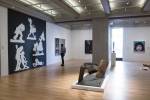After a five-year, $33million renovation project, the Wadsworth Atheneum has opened an extensive new display of post-war and contemporary art. We asked Patricia Hickson, the Emily Hall Tremaine Curator of Contemporary Art, to pick a few of her personal highlights from the galleries.
Jackson Pollock
Number 9 (1949)
This signature Pollock drip painting is of modest scale, but you can easily get lost in the multi-coloured layers of stringy drips, highlighted with shimmering silver loops of paint. This work is part of a group of seven Abstract Expressionist paintings donated to the museum in 1967 by sculptor Tony Smith, who had just had his first solo museum exhibition (curated by Sam Wagstaff) the previous year. The paintings from this important gift are shown in a single gallery space that includes several small-scale Smith sculptures, and his large-scale Amaryllis (1965) visible on the grounds through the gallery window.
Robert Rauschenberg
Retroactive I (1964)
My favourite painting in the collection, the iconic Retroactive I by Rauschenberg is (in my opinion) the best of a series of eight paintings built around a press photograph of President John F. Kennedy, who had recently been assassinated. The artist’s vibrantly coloured composition was screenprinted as a collage of disparate images from media, popular culture, and everyday life, which fits squarely into the Pop art movement. Apparently, Rauschenberg conceived of the painting before the president’s death based on Kennedy’s popularity and ubiquity in the press. In the aftermath, the painting takes on a memorial quality and the lost promise of America embodied in the youthful president.
Sol LeWitt
Wall Drawing #352 (1980)
The first LeWitt wall drawing to enter the collection of the Wadsworth, this important work has been off-view to the public for more than a decade. Originally designed for the rebuilt Civic Center in Hartford, the artist quickly withdrew the commission when city leaders began to grumble. (This was on the heels of another public artwork controversy over Stone Field Sculpture by Minimalist artist Carl Andre in 1977.) In a show of support for the artist and his work, the museum acquired LeWitt’s Civic Center wall drawing, which was revised for the museum space. A native of Hartford, LeWitt took his first art classes at the Wadsworth as a boy, and maintained a lifelong relationship with the museum. Today, the Wadsworth has more than 300 works by LeWitt in the collection – more than any other single artist.
James Nares
STREET (2012)
Nares’ mesmerising video takes the viewer on an hour-long journey through the streets of Manhattan, from north to south and east to west. The slow motion adventure captures innumerable special moments in everyday life on the sidewalks of New York, the camera largely unseen by those recorded. Accompanied by a musical soundtrack by Sonic Youth guitarist Thurston Moore, it is nearly impossible to tear oneself away from this moving portrait of the lively city.
Kara Walker
Wall Sampler 1 (2013)
New to the collection, Walker’s large installation features a sampling of five white-paper silhouettes on a 12-by-12 foot black field. Typical of the artist’s work, the traditional 18th-century silhouette portrait form is turned on its head. Walker’s caricatures of Civil War era soldiers and slaves are depicted in vignettes of racist acts and sexual violence, behaviours that, unfortunately, continue to this day.
The new post-war and contemporary galleries at the Wadsworth Atheneum Museum of Art opened on 31 January.











